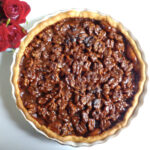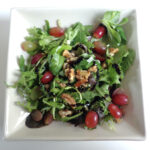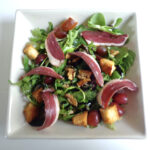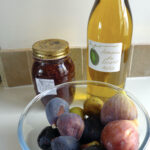 Bourride is a Mediterranean fish dish bathed in a sauce infused with garlic and inflected with hints of orange and sunshine. If you’ve been to the French Riviera you may have had the luck to encounter it. Elsewhere there’s little chance you would have run into this undeservedly lesser known cousin of bouillabaisse. I’ve rarely seen it in restaurants in Paris. Which is why, shortly after tasting it for the first time, I learned how to make it.
Bourride is a Mediterranean fish dish bathed in a sauce infused with garlic and inflected with hints of orange and sunshine. If you’ve been to the French Riviera you may have had the luck to encounter it. Elsewhere there’s little chance you would have run into this undeservedly lesser known cousin of bouillabaisse. I’ve rarely seen it in restaurants in Paris. Which is why, shortly after tasting it for the first time, I learned how to make it.
Bourride / Bourride
The star of bourride is aïoli, aka garlic mayonnaise. Unlike a normal mayonnaise, aïoli consists only of egg yolks, garlic and olive oil — no mustard, no lemon juice. The first step in making the dish is to create a fragrant broth that includes a strip of dried orange peel. While the broth is cooking, you make the aïoli and cut up some veggies — carrots and finocchio — as well as the fish. But which fish?
There are probably as many recipes for bourride as there are chefs in Provence. Some use monkfish (lotte), which has the considerable advantage of holding together nicely when it is boiled. But any firm, white-fleshed fish may be used. In the photo above, I used cod.
To complete the dish, the veggies are sautéed in olive oil, simmered until nearly tender in the broth, and then the fish is added. Aïoli is swirled in at the end, with an extra yolk added to thicken the sauce. Serve and prepare for applause.
Because of the delicate chemistry of the sauce, bourride must be served immediately upon preparation. Which raises the question of what to serve as a first course. My recommendation would be to offer hors d’oeuvres during cocktail hour — something that may be eaten before moving to the table, like parmesan apéritif chips, a savory cake with walnuts and roquefort or chicken liver pâté on toast. Then, while your guests are enjoying themselves, you can disappear to the kitchen and finish the dish.
Following up, you could serve a salad of tender leaves (mesclun), with cheese during or after, and a fruity dessert, for example poires au caramel (caramelized pears). And a good bourride deserves a good wine, from the region if possible, such as a chilled white from Cassis or rosé from Bandol. Bon appétit! And…
Happy cooking.

 Stuffed eggs topped with red caviar make a simple yet elegant dish that’s perfect for special occasions. Do I hear New Year’s Eve, anyone? Or brunch on the morning after? Most French takes on this dish call for the eggs to be scrambled. This recipe, with hard-boiled eggs, has a more Russian flavor. In the old days, Russians often served the eggs topped with black caviar — but with the sturgeon now an endangered species, red caviar is used instead.
Stuffed eggs topped with red caviar make a simple yet elegant dish that’s perfect for special occasions. Do I hear New Year’s Eve, anyone? Or brunch on the morning after? Most French takes on this dish call for the eggs to be scrambled. This recipe, with hard-boiled eggs, has a more Russian flavor. In the old days, Russians often served the eggs topped with black caviar — but with the sturgeon now an endangered species, red caviar is used instead. On occasions like New Year’s Eve, the eggs may be served as part of an hors d’oeuvre spread. They would marry well with
On occasions like New Year’s Eve, the eggs may be served as part of an hors d’oeuvre spread. They would marry well with  If you’d like to serve something different this holiday season, why not consider côte de boeuf? A bone-in rib of beef that is served as steak, and not as a roast, côte de boeuf is a popular cut is France. It is ultratender, flavorful and easy to prepare. If you can convince your butcher to cut the meat as the French do, then this elegant dish would make a lovely centerpiece to a festive meal, perhaps accompanied, as shown here, by a cauliflower gratin.
If you’d like to serve something different this holiday season, why not consider côte de boeuf? A bone-in rib of beef that is served as steak, and not as a roast, côte de boeuf is a popular cut is France. It is ultratender, flavorful and easy to prepare. If you can convince your butcher to cut the meat as the French do, then this elegant dish would make a lovely centerpiece to a festive meal, perhaps accompanied, as shown here, by a cauliflower gratin. A côte de boeuf is the equivalent of an American ribeye steak, with the bone included. It is prepared in two stages. First the meat is pan-seared to seal in the juices. It is then roasted for a relatively short time in a very hot oven, allowed to rest briefly and sliced off the bone. Nothing is added until the very end, when the meat is salted and peppered. When buying the rib pictured here, I asked Marie Pacaud, who presides over the excellent Boucherie du Marais, whether to rub the meat with garlic. I received the French equivalent of fuhgeddaboudit: the Gallic shrug. ‘That would distort the flavor,’ she said drily.
A côte de boeuf is the equivalent of an American ribeye steak, with the bone included. It is prepared in two stages. First the meat is pan-seared to seal in the juices. It is then roasted for a relatively short time in a very hot oven, allowed to rest briefly and sliced off the bone. Nothing is added until the very end, when the meat is salted and peppered. When buying the rib pictured here, I asked Marie Pacaud, who presides over the excellent Boucherie du Marais, whether to rub the meat with garlic. I received the French equivalent of fuhgeddaboudit: the Gallic shrug. ‘That would distort the flavor,’ she said drily.
 This unusual wild mushroom risotto is the creation of John O’Shea, the brilliant young British chef who presides over the kitchen at JJ Beaumarchais, a restaurant downstairs from my apartment. It is unusual first because instead of rice it uses épeautre, known in English variously as spelt or einkorn wheat, and second because, unlike most risottos, the ingredients are cooked separately and combined only just before serving.
This unusual wild mushroom risotto is the creation of John O’Shea, the brilliant young British chef who presides over the kitchen at JJ Beaumarchais, a restaurant downstairs from my apartment. It is unusual first because instead of rice it uses épeautre, known in English variously as spelt or einkorn wheat, and second because, unlike most risottos, the ingredients are cooked separately and combined only just before serving. I made the dish three times last month, using a different combination of mushrooms each time. Pictured at right are four types I’ve tried. Going clockwise from the top left, they are in French, chanterelles, pleurotes, shitake and girolles. This may be a bit confusing, because what the French call girolles are called ‘chanterelles’ in English. But it doesn’t matter because you can use whatever is available in your area. I have also used the papery black mushrooms called trompettes de la mort (‘trumpets of death’), which despite their scary name are not poisonous and are indeed very popular over here.
I made the dish three times last month, using a different combination of mushrooms each time. Pictured at right are four types I’ve tried. Going clockwise from the top left, they are in French, chanterelles, pleurotes, shitake and girolles. This may be a bit confusing, because what the French call girolles are called ‘chanterelles’ in English. But it doesn’t matter because you can use whatever is available in your area. I have also used the papery black mushrooms called trompettes de la mort (‘trumpets of death’), which despite their scary name are not poisonous and are indeed very popular over here. Walnut tart, a specialty of southwest France, is a favorite of mine in the autumn. The walnut pieces are bathed in a caramel sauce and then baked in a tender tart shell to produce a sweet, chewy confection — comfort food at its finest. This tart would make a nice innovation on Thanksgiving, and could add a festive touch on Christmas or New Years. With the holidays arriving, I wanted to share the recipe with you. There was only one problem…
Walnut tart, a specialty of southwest France, is a favorite of mine in the autumn. The walnut pieces are bathed in a caramel sauce and then baked in a tender tart shell to produce a sweet, chewy confection — comfort food at its finest. This tart would make a nice innovation on Thanksgiving, and could add a festive touch on Christmas or New Years. With the holidays arriving, I wanted to share the recipe with you. There was only one problem… Can you imagine the slopes of Mount Etna after a volcanic eruption? This is how my tart came out of the oven, with hills and crannies that looked like solidified lava and were just as hard. I’d made the tart for a dinner party that evening, and my guests gamely agreed to try it. Not too bad, I guess, because they asked for more — although one remarked that he had never before seen a tart that looked like a lunar landscape.
Can you imagine the slopes of Mount Etna after a volcanic eruption? This is how my tart came out of the oven, with hills and crannies that looked like solidified lava and were just as hard. I’d made the tart for a dinner party that evening, and my guests gamely agreed to try it. Not too bad, I guess, because they asked for more — although one remarked that he had never before seen a tart that looked like a lunar landscape. By the way, another autumn dessert I love is pear clafoutis, which I posted back in 2012, when this site was just getting started. I made it again recently and updated the recipe with a better photo. If you’d like to try it, the recipe is
By the way, another autumn dessert I love is pear clafoutis, which I posted back in 2012, when this site was just getting started. I made it again recently and updated the recipe with a better photo. If you’d like to try it, the recipe is  This is one of those French salads with an evocative name where the ingredients vary according to the whim of the chef. Salade vigneronne translates as ‘winemaker’s salad’, and in this version you’ll find tender leaves, walnuts, grapes and garlic in a balsamic vinaigrette, with optional add-ons such as smoked duck breast, dry-cured ham or croutons. It’s a salad I serve often in autumn. But when I surfed the web to see how others do it…
This is one of those French salads with an evocative name where the ingredients vary according to the whim of the chef. Salade vigneronne translates as ‘winemaker’s salad’, and in this version you’ll find tender leaves, walnuts, grapes and garlic in a balsamic vinaigrette, with optional add-ons such as smoked duck breast, dry-cured ham or croutons. It’s a salad I serve often in autumn. But when I surfed the web to see how others do it… Getting back to salade vigneronne, my theory on why there are so many versions is that the name harks back to the tradition of winemakers serving hearty food to the workers they hire in autumn to pick their grapes. Although I’ve never participated in the vendanges (grape harvest), I hear it’s back-breaking work that deserves a substantial lunch. My lighter version of the salad may be served as a starter or as a lunch dish, followed perhaps by some cheese, and with a glass of red alongside. It would also make a nice dish to serve on the upcoming November holidays — Hanukah and Thanksgiving.
Getting back to salade vigneronne, my theory on why there are so many versions is that the name harks back to the tradition of winemakers serving hearty food to the workers they hire in autumn to pick their grapes. Although I’ve never participated in the vendanges (grape harvest), I hear it’s back-breaking work that deserves a substantial lunch. My lighter version of the salad may be served as a starter or as a lunch dish, followed perhaps by some cheese, and with a glass of red alongside. It would also make a nice dish to serve on the upcoming November holidays — Hanukah and Thanksgiving. Meantime, as to what else I’ve been up to in the kitchen, I made a wedding cake this past week. Great fun!
Meantime, as to what else I’ve been up to in the kitchen, I made a wedding cake this past week. Great fun! I was inspired to make this Normandy dish of chicken cooked in hard cider by the late great writer Marguerite Duras. Not that she made it for me, but I did enjoy meals at her house — more on that later. The dish originated as peasant fare for special occasions. The chicken is lightly browned, mushrooms, shallots and bacon are added, and the dish is then stewed in hard cider, with cream added at the end. By the way, Normandy grows a lot of apples.
I was inspired to make this Normandy dish of chicken cooked in hard cider by the late great writer Marguerite Duras. Not that she made it for me, but I did enjoy meals at her house — more on that later. The dish originated as peasant fare for special occasions. The chicken is lightly browned, mushrooms, shallots and bacon are added, and the dish is then stewed in hard cider, with cream added at the end. By the way, Normandy grows a lot of apples. I discovered the apéritif known as ratafia one summer when the former owners of my cottage in Burgundy paid me a visit. As they admired the changes I’d made inside, I asked them how they had used the grapes growing on a sprawling vine outside. Since the grapes were too sour to eat, I had been leaving them to the birds. But I was sure that previous owners, including those who planted the grapevine in the first place, must have had a better idea.
I discovered the apéritif known as ratafia one summer when the former owners of my cottage in Burgundy paid me a visit. As they admired the changes I’d made inside, I asked them how they had used the grapes growing on a sprawling vine outside. Since the grapes were too sour to eat, I had been leaving them to the birds. But I was sure that previous owners, including those who planted the grapevine in the first place, must have had a better idea. In Burgundy, where grapes are plentiful, making ratafia in the autumn is an annual pastime. And now that I’ve sold my cottage, I make it in Paris. It’s fun, inexpensive and the results are thoroughly enjoyable.
In Burgundy, where grapes are plentiful, making ratafia in the autumn is an annual pastime. And now that I’ve sold my cottage, I make it in Paris. It’s fun, inexpensive and the results are thoroughly enjoyable. I was inspired to make a carpaccio of tuna the other day after lunching in Montmartre at a place that served a fabulous version infused with Asian flavors. I didn’t think to ask for the recipe, so I had to wing it. In this version, ultrafresh tuna is flavored with a marinade of lime zest, lime juice, sesame oil, ginger and soy sauce, and topped with toasted sesame seeds and cilantro. For a gala touch, I added a sprinkle of trout roe.
I was inspired to make a carpaccio of tuna the other day after lunching in Montmartre at a place that served a fabulous version infused with Asian flavors. I didn’t think to ask for the recipe, so I had to wing it. In this version, ultrafresh tuna is flavored with a marinade of lime zest, lime juice, sesame oil, ginger and soy sauce, and topped with toasted sesame seeds and cilantro. For a gala touch, I added a sprinkle of trout roe. Fresh figs marry beautifully with goat cheese and rosemary, so I decided to combine them in a savory tart. I came up with this plan after my downstairs neighbor brought me a bucketful of figs — lush, plump and ultra flavorful — from her vacation place in Sardinia. Although it’s theoretically the height of fig season in France now, too, there’s been a dearth of homegrown figs this year, making me all the more grateful for the gift.
Fresh figs marry beautifully with goat cheese and rosemary, so I decided to combine them in a savory tart. I came up with this plan after my downstairs neighbor brought me a bucketful of figs — lush, plump and ultra flavorful — from her vacation place in Sardinia. Although it’s theoretically the height of fig season in France now, too, there’s been a dearth of homegrown figs this year, making me all the more grateful for the gift. On my first go, I made the pastry myself, using the
On my first go, I made the pastry myself, using the  At left, the gifts from my neighbor: figs from her fig tree, her homemade fig jam (fabulous!), and a bottle of olive oil pressed from olives grown on her property.
At left, the gifts from my neighbor: figs from her fig tree, her homemade fig jam (fabulous!), and a bottle of olive oil pressed from olives grown on her property.

